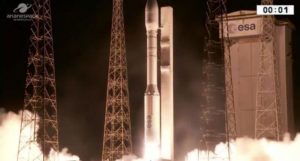
Arianespace has successfully launched the MOHAMMED VI–A satellite dedicated for Earth observation for the Kingdom of Morocco. The satellite was developed by the consortium comprising Thales Alenia Space as system prime contractor and Airbus as co-prime.
The launch took place on Tuesday, November 7, 2017, at 10:42:31 p.m. (local time) from the Guiana Space Center (CSG), Europe’s Spaceport in French Guiana (South America).
With this 11th success for Vega since 2012, Arianespace continues to demonstrate the exceptional reliability of its light launcher and its perfect adaptation to the needs of institutional and commercial customers.
Eighth Earth observation mission for Vega
The light, versatile Vega launcher carried out its eighth launch of an Earth observation satellite.
The MOHAMMED VI–A satellite will be used in particular for mapping and land surveying activities, regional development, agricultural monitoring, the prevention and management of natural disasters, monitoring changes in the environment, and desertification.
Thales Alenia Space, as system prime contractor, supplied the payload, including the optical instrument, the image transmission subsystem, and the ground segment for image processing and production. Airbus, as satellite prime contractor, was in charge of its integration, as well as supplying the platform and the ground segment for mission planning and satellite control.
Including this latest mission, Arianespace has now orbited 64 Earth observation satellites for both government and commercial customers, in particular the European Copernicus programme and the Eumetsat operator of meteorological satellites.
Arianespace continues to confirm its position as a key player in the dynamic Earth observation market, which represents 10% of the satellites already launched by the company, and 30% of the order book (in number of contracts).
Vega at a glance
– 2012: first launch from CSG.
– 11 launches, all successful, including eight for Earth observation satellites.
– 26 satellites launched (13 for Earth observation, 11 for technology applications, and two for scientific missions).
– 11.3 metric tons orbited.
– Six launches in the order book (all for Earth observation)
Eleventh consecutive success for Vega, which is three-for-three in 2017
As the 11th consecutive success for Vega, Flight VV11 also is the 10th Arianespace launch since the beginning of 2017 and the third launch of Vega during the same period.
It also marks the second Vega mission by Arianespace using a new operational organization in conjunction with its partner Avio, industrial prime contractor for Vega. Avio now assumes responsibility for preparing the launcher until its liftoff (H0), while Arianespace maintains full responsibility for customer relations, as well as final countdown operations and the launch decision.
Vega C is the upgraded version of this launcher, slated for a first flight in 2019. Between June and September 2017, the first three launch contracts were booked for this launch vehicle with both commercial and institutional customers. Compared with the current version, Vega C will offer higher performance in terms of payload capacity (weight and volume), along with the operational flexibility to handle an even larger variety of missions (from nanosatellites to large optical and radar observation satellites), which will further boost the competitiveness of Arianespace’s launch services.
Arianespace now has a backlog of nine missions for Vega and Vega C; one-third are for European institutions and two-thirds are for export customers, clearly confirming the validity of its launch services offering for satellites in the under 1.5-metric-ton class.
Shortly after the announcement of the orbital injection of the MOHAMMED VI–A satellite, Arianespace Chief Executive Officer Stéphane Israël said: “On the occasion of this 11th consecutive success of the Vega launcher since its introduction at the Guiana Space Center, Arianespace is very proud to serve the Kingdom of Morocco for the first time. We are honored by Morocco’s confidence in the launching of the iconic satellite MOHAMMED VI-A dedicated for Earth observation. Congratulations to Thales Alenia Space, system prime contractor and to Airbus, co-prime of the satellite. Both are long-standing partners.
Today, Vega marked its third successful launch in 2017, demonstrating both its reliability and availability. I would like to congratulate all our partners for this success: the teams of our prime contractor, Avio; the European Space Agency, for its active support for the Vega program, of which the Italian Space Agency is the main contributor; CNES/CSG; our industrial ground segment companies; and all employees of the launch base – always with us for new successes. Finally, congratulations to the Arianespace teams for the 10th successful launch this year.”
The MOHAMMED VI–A satellite separated from the launcher 55 minutes and 33 seconds after liftoff, and was placed in a Sun-synchronous orbit (SSO). It weighed 1,110 kg. at launch.
Original published at: https://spacewatch.global/2017/11/moroccos-mohammed-vi-earth-observation-satellite-successfully-launched-arianespace/
 SpaceWatch.Global An independent perspective on space
SpaceWatch.Global An independent perspective on space

